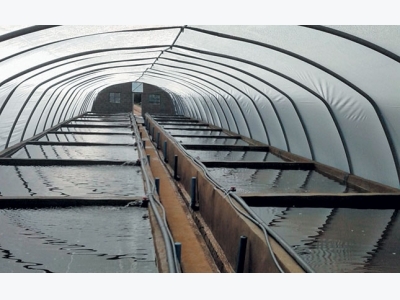Aquaculture 101: the advantages of greenhouse tunnels

Want cost-effective heating for your aquaculture system? Nothing beats greenhouse tunnels.
Simple, hemispherical, framed structures with close frame-spacing are best.Photo: Nicholas James
Greenhouse tunnels provide an energy-free solution to heating the water in an aquaculture system. No other method is as energy-efficient. The design of these tunnels varies widely, however, and not all structures are suitable for aquaculture systems.
The sun’s radiation passes through the plastic sheeting as shortwave radiation. Once it has been reflected by the ground, the radiation changes to a longer wave, which is trapped inside the sheeting, warming the air.
Most sheeting is designed for plants, so comes in white or green to scatter the light and prevent plants from burning. Fish systems require maximum heating, so 100% transparent sheeting is preferable.
Frames
A greenhouse tunnel often features cross-bracing to strengthen the roof for trellises. This is unnecessary in an aquaculture tunnel, where a simple hemispherical frame is adequate, and cheaper. A hemispherical frame also allows the force of the wind to be spread evenly.
Many tunnels are vertical-sided with curved roofs; these are weaker, but some offer roll-up side flaps for ventilation.
A tunnel should be made of robust tubing or rectangular sections and steel frames should be galvanised. In winter, when the tunnels are not ventilated, the humidity can cause condensation that ‘rains’ from the roof.
Some Chinese-manufactured tunnels use tubular aluminium; although excellent, they need cross-bracing for rigidity.
The frames are usually 3m apart.
Sheeting can be secured in various ways. In some designs, it is buried and tensioned in a trench on either side of the frame. In others, it is clamped over a horizontal beam. Sometimes, it is further secured with diagonal ropes.
To prevent the hot metal of the frames from burning holes through the sheeting, the upper surfaces of the frames should be painted with white PVA or covered with white tape.
For maximum strength, end-walls are best bricked up, and fitted with doors and ventilation windows. A tunnel with well-stretched sheeting and bricked-up end-walls can last for 12 years.
Protection and costs
Wind, hail and fire are the enemies of tunnels. For protection against wind, the tunnel should be sited end-on to the prevailing wind, and sheltered by buildings or windbreaks.
Netting stretched over a frame above the tunnel will provide protection from hail.
To avoid fire damage, the structure should be placed as far as possible from vegetation or separated from it by a firebreak.
Home-made tunnels are seldom viable. Flat sheets of plastic over wooden frames have a short lifespan as the plastic is usually supported unevenly, and ends up flapping and being chafed to destruction.
Tunnels are expensive – from R42 000 for a 30m x 10m frame to R85 000 or more for a 50m x 12m frame with plastic.
To make the best use of the limited floor space under the tunnel, interlinked rectangular tanks should be used rather than circular tanks.
Có thể bạn quan tâm
 Choosing the right aquaculture technology
Choosing the right aquaculture technology Successful aquaculture is all about making a profit. Make sure your system is affordable and appropriate
 How to set up an aquaponics system
How to set up an aquaponics system Starting small will not necessarily give you an accurate idea of what to expect when going commercial.
 Which design is best?
Which design is best? The design of an aquaculture system is essential to the operation’s success, and should be appropriate to environmental conditions and staffing skills.